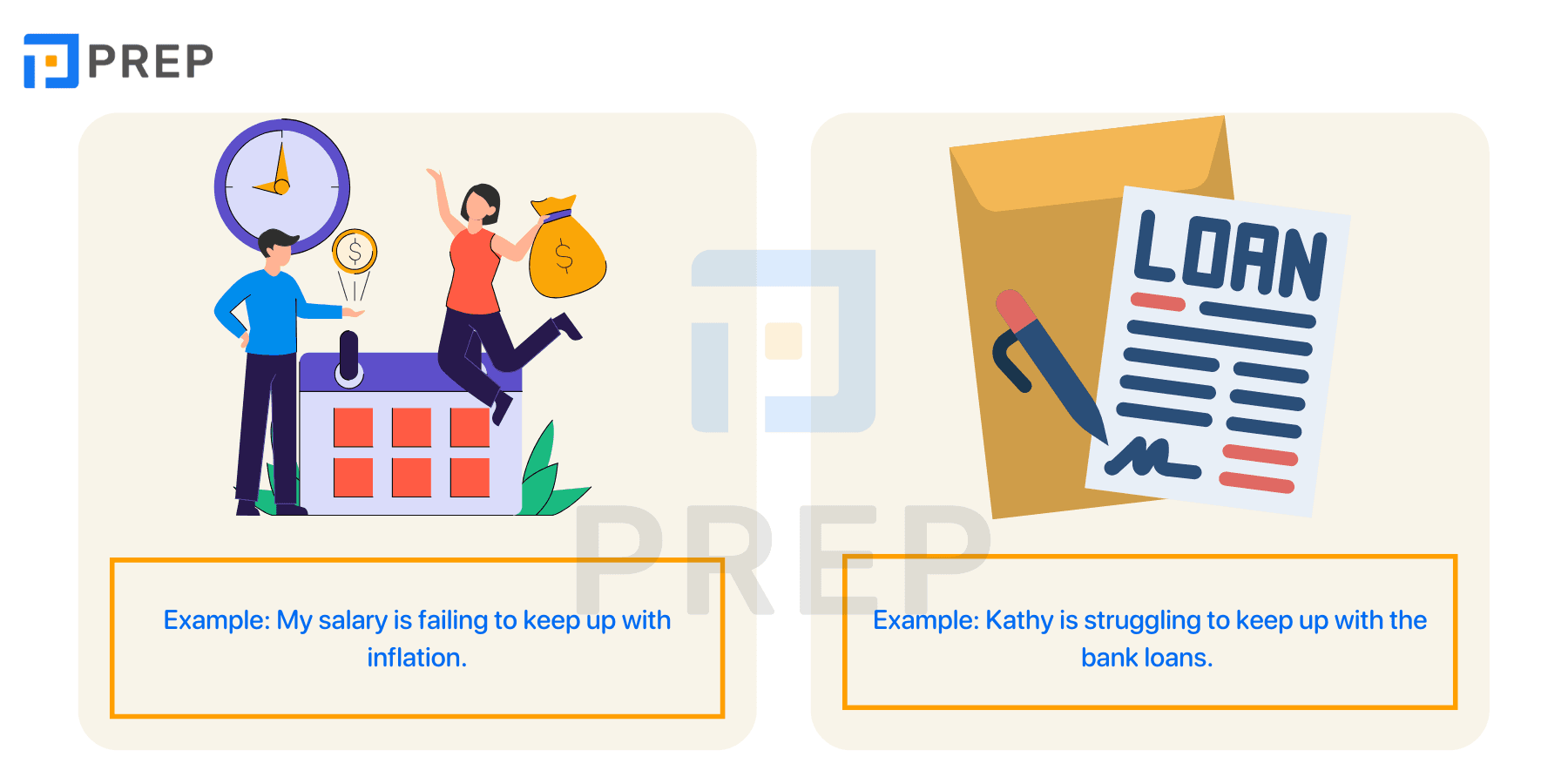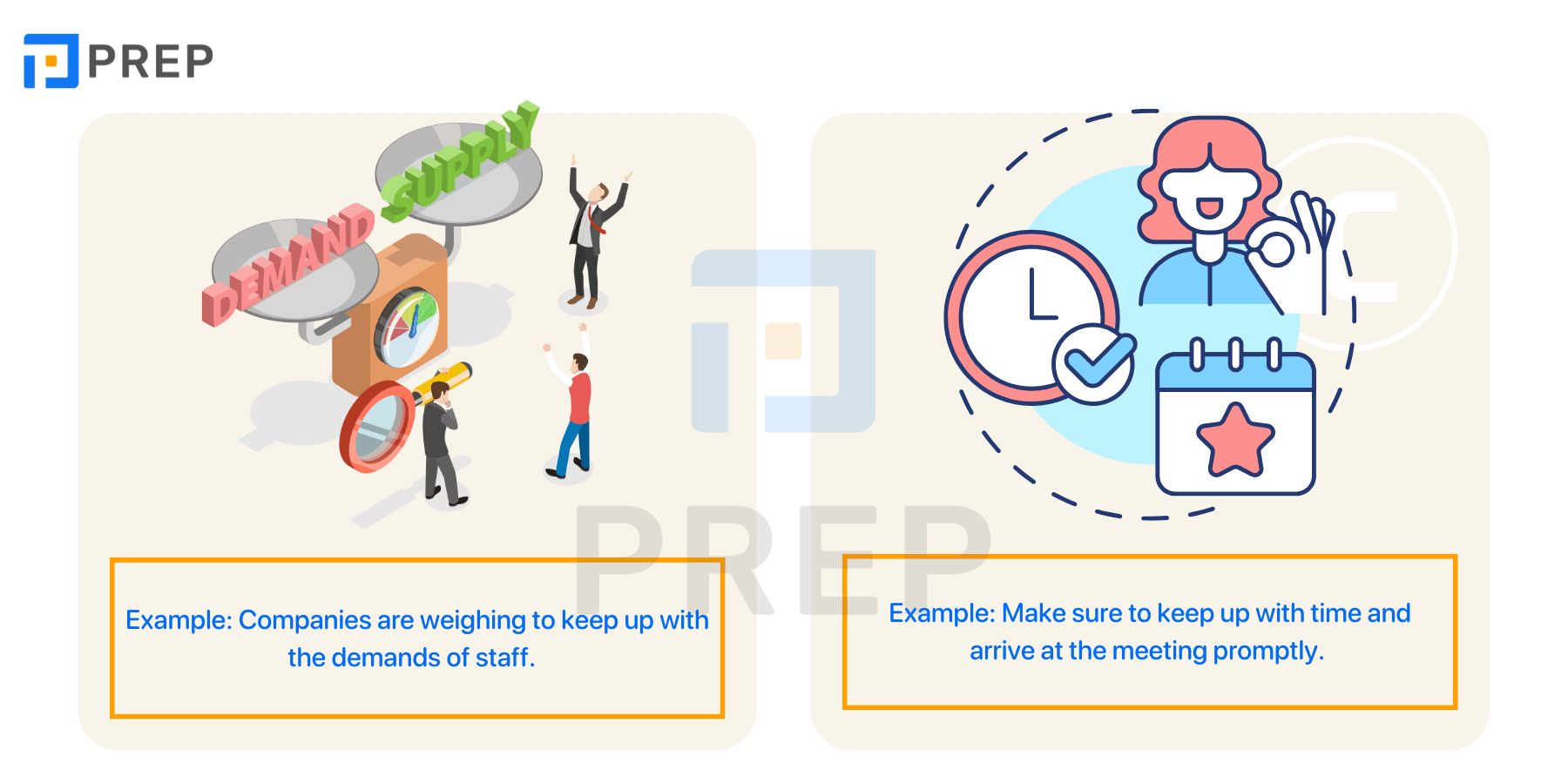Keep up with in English: Meaning, Grammar and Use
Keep up with in English is a common phrasal verb that means to stay at the same level, follow trends, or maintain progress. This guide explains its meaning, grammar rules, and sentence structures, compares it with similar expressions, and provides examples and exercises to help learners practice effectively.

I. What is Keep up with in English?
“Keep up with” is a phrasal verb that means to stay at the same level or pace as someone or something. It is commonly used in both spoken and written English to express the idea of not falling behind—whether in terms of speed, progress, understanding, or development. It belongs to a group of phrasal verbs in English that combine verbs with prepositions to form new meanings.
The core meaning of keep up with can be summarized as:
- To stay informed or updated about something
- To match progress or performance compared to others
- To maintain pace in terms of physical movement, ability, or mental focus
"Keep up with" is a flexible expression that appears in a variety of real-life contexts:
- Education: I can’t keep up with the rest of the class.
- Workplace: It’s hard to keep up with the constant changes in the industry.
- Technology: My parents struggle to keep up with modern digital tools.
- Everyday life: I haven’t been able to keep up with the news this week.

Formality Level
- Generally considered informal to neutral
- Used frequently in conversations, emails, online writing, and general-purpose communication
- Can appear in semi-formal or academic writing, especially when describing trends, updates, or progress (e.g., in IELTS Writing Task 2)
Understanding how "keep up with" functions helps learners use it appropriately in both casual and semi-formal contexts—and apply it effectively when discussing development, comparison, or effort.
1. Grammar Rules for Using Keep up with in English
“Keep up with” is a phrasal verb that follows a consistent and flexible grammatical structure. It can be used across various tenses and contexts, with both literal and figurative meanings.
The core sentence structure is:
Subject + keep/kept + up with + object
- Subject: person or thing performing the action
- Keep/Kept: verb (conjugated depending on tense)
- Up with: fixed prepositional phrase
- Object: the thing or person being kept up with, forming part of fixed prepositional phrases in phrasal verbs.
Example:
- She keeps up with fashion trends.
- They couldn’t keep up with the pace.
Verb Conjugation Table: “Keep” in Different Tenses
|
Tense |
Structure |
Example Sentence |
|
Present Simple |
keep(s) up with |
I keep up with my reading list every week. |
|
Past Simple |
kept up with |
He kept up with the rest of the runners. |
|
Present Continuous |
am/is/are keeping up with |
She is keeping up with her online course. |
|
Present Perfect |
has/have kept up with |
We have kept up with all the recent updates. |
|
Future (will) |
will keep up with |
They will keep up with the latest technologies. |
|
Modal verb + base form |
can/must/might keep up with |
You should keep up with your assignments. |
Common Meanings and Usage Contexts
Below is a summary of the main meanings of “keep up with”, along with example sentences for each.
|
Meaning |
Explanation |
Example |
|
1. Stay updated |
To remain informed about trends, news, or events |
I can’t keep up with all the news these days. |
|
2. Match pace or progress |
To move or advance at the same speed or level |
He runs too fast—I can’t keep up with him. |
|
3. Maintain performance or standards |
To not fall behind in work, studies, or responsibilities |
She’s struggling to keep up with her schoolwork. |
2. “Keep Up With” vs Similar Expressions
“Keep up with” is often confused with other expressions that share similar meanings related to progress, pace, or awareness. However, there are subtle differences in usage, formality, and grammatical structure. Understanding the distinctions helps learners choose the right expression in the right context.
Common Alternatives to “Keep Up With”
|
Expression |
Core Meaning |
Formality |
Typical Usage |
|
Keep up with |
Stay at the same level or pace; remain updated |
Neutral |
work, news, trends, school, people |
|
Catch up with |
Reach the same level after falling behind |
Neutral |
missed assignments, conversations, backlog |
|
Stay on top of |
Stay fully in control or well-informed |
Semi-formal |
responsibilities, news, work updates |
|
Follow |
Know regularly about developments or activities |
Neutral/Formal |
social media, instructions, rules |
|
Stay up to date with |
Remain current and aware of latest information |
Formal/Neutral |
business, technology, regulations |
Key Differences
- Keep up with implies ongoing action to maintain pace or awareness without falling behind.
Example: I try to keep up with the latest tech trends. - Catch up with is used when you are already behind and need to recover lost ground.
Example: I need to catch up with yesterday’s homework. - Stay on top of suggests being proactive and in control of something.
Example: She always stays on top of her deadlines. - Follow is more passive; it refers to observing or paying attention to updates.
Example: Do you follow this podcast? - Stay up to date with is commonly used in professional or academic contexts, similar to “keep up with” but slightly more polished.
Example: It's important to stay up to date with industry policies.
When to Use “Keep Up With”
- Describing effort to maintain the same pace or level as others
- Talking about staying informed or adapting to change
- Writing semi-formal content (emails, IELTS essays, business English)
Avoid using it interchangeably with “catch up with” as the intent is different—one is preventive, the other corrective.

II. Examples of Keep up with in English
Looking at real examples of how “keep up with” is used in various contexts will help you understand its flexibility and meaning more clearly. Below are categorized examples to show how this phrasal verb functions in everyday conversation, academic or professional contexts, and standardized test situations such as IELTS or TOEFL.
Everyday Use
“Keep up with” is commonly used in casual conversation to talk about staying updated, not falling behind, or maintaining pace.
- I can’t keep up with all these group chats!
- She walks too fast—I can’t keep up with her.
- He tries to keep up with the news, but he’s been busy lately.
- They spent extra hours studying to keep up with the rest of the class.
- I’m trying to keep up with my workout routine this month.
Academic and Professional Use
In more formal writing and communication, the phrase often relates to trends, expectations, or information flow.
- The company invests in training so that employees can keep up with digital advancements.
- It’s difficult for educators to keep up with rapid changes in technology.
- Students must keep up with weekly readings to succeed in this course.
- Researchers need to keep up with the latest publications in their field.
- Professionals who fail to keep up with regulatory updates may fall behind competitors.
IELTS / TOEFL-Style Examples
Using phrasal verbs like "keep up with" in language proficiency exams adds natural variety to your vocabulary and grammatical range, especially in Speaking and Writing tasks.
- IELTS Speaking (Part 1):
Q: How do you usually stay informed about current events?
A: I usually read online newspapers and listen to short news podcasts to keep up with what’s going on around the world. - IELTS Writing (Task 2):
In today’s fast-moving society, it is becoming increasingly important for people of all ages to keep up with technological developments. - TOEFL Integrated Speaking:
According to the lecture, successful workers constantly put in effort to keep up with changes in their industry. - TOEFL Writing (Independent Task):
People should select careers in emerging industries, so they can grow and keep up with market demands.
These examples show that "keep up with" is a versatile expression used across a wide range of registers—from casual talk to formal essays. Understanding its use in different contexts will help you apply it with confidence in both everyday and academic English.
III. Practice with Keep up with in English
Practicing how to use “keep up with” in different contexts is essential to build confidence and fluency. Below are three common types of exercises designed to help you reinforce your understanding of this phrasal verb through sentence construction, reformulation, and error correction.
Exercise 1. Fill in the blanks
Complete the sentences using the correct form of “keep up with”.
- I find it hard to __________ the changes in mobile phone technology.
- He couldn't __________ the rest of the group during the hike.
- She's been trying to __________ her studies despite working full-time.
- You should read more if you want to __________ current events.
- I listen to tech podcasts to __________ new trends in the industry.
Exercise 2. Rewrite the sentences using “keep up with”
Rephrase each sentence so that it includes “keep up with”, keeping the original meaning.
- I stay informed about world news by watching the BBC every morning.
→ ................................................................................... - She couldn't match the speed of her teammates on the field.
→ ................................................................................... - We update our knowledge regularly to remain competitive.
→ ................................................................................... - He studies hard because he doesn’t want to fall behind in class.
→ ................................................................................... - I check my emails daily so I don’t miss any work updates.
→ ...................................................................................
Answer
[prep_collapse_expand open_text="View more" close_text="Show less"]
|
Exercises 1 |
Exercises 2 |
|
|
[/prep_collapse_expand]
PREP hopes that through the knowledge summarized in the article above, you have grasped the usage and structure of Keep up with in English. Don't forget to follow PREP regularly to update more useful knowledge!

Hi I'm Chloe, and I am currently serving as an Product Content Administrator at Prep Education. With over five years of experience in independent online IELTS study and exam preparation, I am confident in my ability to support learners in achieving their highest possible scores.
Comment
Premium content
View allPersonalized roadmap
Most read












